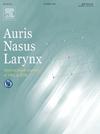Treatment outcomes of 73 cases of external auditory canal squamous cell carcinoma: A single-center six-year analysis in Japan
IF 1.5
4区 医学
Q2 OTORHINOLARYNGOLOGY
引用次数: 0
Abstract
Objectives
External auditory canal cancer (EAC) is a rare type among head and neck cancers, predominantly composed of squamous cell carcinoma (SCC) pathologically. Various comprehensive treatments including surgery, radiation therapy, and chemotherapy are conducted in many facilities for squamous cell carcinoma of the external auditory canal. However, due to its rarity, there is no established standard treatment. This study aimed to report the treatment outcomes at our single facility and prognostic factors post-surgery for EAC-SCC.
Methods
We conducted a retrospective analysis of 73 cases of EAC-SCC, which underwent initial treatment at our facility from July 2015 to November 2022. We utilized the modified Pittsburgh classification for TNM and staging.
Results
There were 37 male and 36 female cases, with a median age of 65 (ranging from 40 to 93). T1: 32 cases, T2: 5 cases, T3: 14 cases, T4: 10 cases. Stage Ⅰ: 28 cases, stage Ⅱ: 5 cases, stage Ⅲ: 12 cases, stage Ⅳ: 16 cases. The median follow-up period was 23.8 months (ranging from 2.8 to 93.6 months). There were 61 cases in the surgery group and 12 cases in the chemoradiotherapy (CRT) group. In survival analysis, the overall 3-year recurrence-free survival (RFS) rate was 81.9 %, and the 3-year disease-specific survival (DSS) rate was 89.1 %. For stage III/IV advanced cancers, the 3-year RFS rate was 78.3 % and DSS rate was 79.1 % in the surgery group, and in the CRT group, they were 66.7 % and 91.7 %, respectively. For T4 cases, the 3-year RFS rate was 58.3 % and DSS rate was 61.0 % in the surgery group, and in the primary CRT group, they were 75.0 % and 87.5 %, respectively. While there were no significant differences in treatment outcomes between the surgery and CRT groups overall, there was a trend suggesting better outcomes in the CRT group for T4 cases. In advanced cases (Stage III/IV, T3/4), younger females tended to be treated with CRT. Positive resection margins (HR: 11.97, 95 % CI: 1.80–79.70, p = 0.010) revealed to be a significant prognostic factor based on RFS.
Conclusion
We reported the treatment outcomes at a single facility and post-surgery prognostic factors. The treatment outcomes at our facility are comparable to other institutions, and in advanced cancers, the CRT group showed a tendency for better treatment outcomes. Post-surgery prognostic factor was positive resection margins.
73例外耳道鳞状细胞癌的治疗结果:日本的一项6年单中心分析
目的外耳道癌(EAC)是头颈部肿瘤中一种少见的类型,病理上以鳞状细胞癌(SCC)为主。外耳道鳞状细胞癌的综合治疗包括手术、放疗、化疗等。然而,由于其罕见性,没有确定的标准治疗方法。本研究旨在报告我们单一机构的治疗结果和术后EAC-SCC的预后因素。方法回顾性分析2015年7月至2022年11月在我院接受初始治疗的73例EAC-SCC患者。我们采用改良的匹兹堡分类进行TNM和分期。结果男性37例,女性36例,中位年龄65岁(40 ~ 93岁)。T1 32例,T2 5例,T3 14例,T4 10例。Ⅰ期28例,Ⅱ期5例,Ⅲ期12例,Ⅳ期16例。中位随访时间为23.8个月(2.8 ~ 93.6个月)。手术组61例,放化疗组12例。在生存分析中,总体3年无复发生存率(RFS)为81.9%,3年疾病特异性生存率(DSS)为89.1%。对于III/IV期晚期肿瘤,手术组3年RFS率为78.3%,DSS率为79.1%,CRT组3年RFS率为66.7%,DSS率为91.7%。对于T4患者,手术组3年RFS为58.3%,DSS为61.0%,首发CRT组3年RFS为75.0%,DSS为87.5%。虽然手术组和CRT组之间的治疗结果总体上没有显著差异,但有一种趋势表明,T4病例的CRT组的治疗结果更好。晚期病例(III/IV期,T3/4期),年轻女性倾向于接受CRT治疗。阳性切缘(HR: 11.97, 95% CI: 1.80-79.70, p = 0.010)是基于RFS的重要预后因素。结论我们报告了在单一机构的治疗结果和术后预后因素。我们的治疗结果与其他机构相当,在晚期癌症中,CRT组显示出更好的治疗结果的趋势。术后预后因素为切缘阳性。
本文章由计算机程序翻译,如有差异,请以英文原文为准。
求助全文
约1分钟内获得全文
求助全文
来源期刊

Auris Nasus Larynx
医学-耳鼻喉科学
CiteScore
3.40
自引率
5.90%
发文量
169
审稿时长
30 days
期刊介绍:
The international journal Auris Nasus Larynx provides the opportunity for rapid, carefully reviewed publications concerning the fundamental and clinical aspects of otorhinolaryngology and related fields. This includes otology, neurotology, bronchoesophagology, laryngology, rhinology, allergology, head and neck medicine and oncologic surgery, maxillofacial and plastic surgery, audiology, speech science.
Original papers, short communications and original case reports can be submitted. Reviews on recent developments are invited regularly and Letters to the Editor commenting on papers or any aspect of Auris Nasus Larynx are welcomed.
Founded in 1973 and previously published by the Society for Promotion of International Otorhinolaryngology, the journal is now the official English-language journal of the Oto-Rhino-Laryngological Society of Japan, Inc. The aim of its new international Editorial Board is to make Auris Nasus Larynx an international forum for high quality research and clinical sciences.
 求助内容:
求助内容: 应助结果提醒方式:
应助结果提醒方式:


